Atkinson K. An Introduction to Numerical Analysis
Подождите немного. Документ загружается.

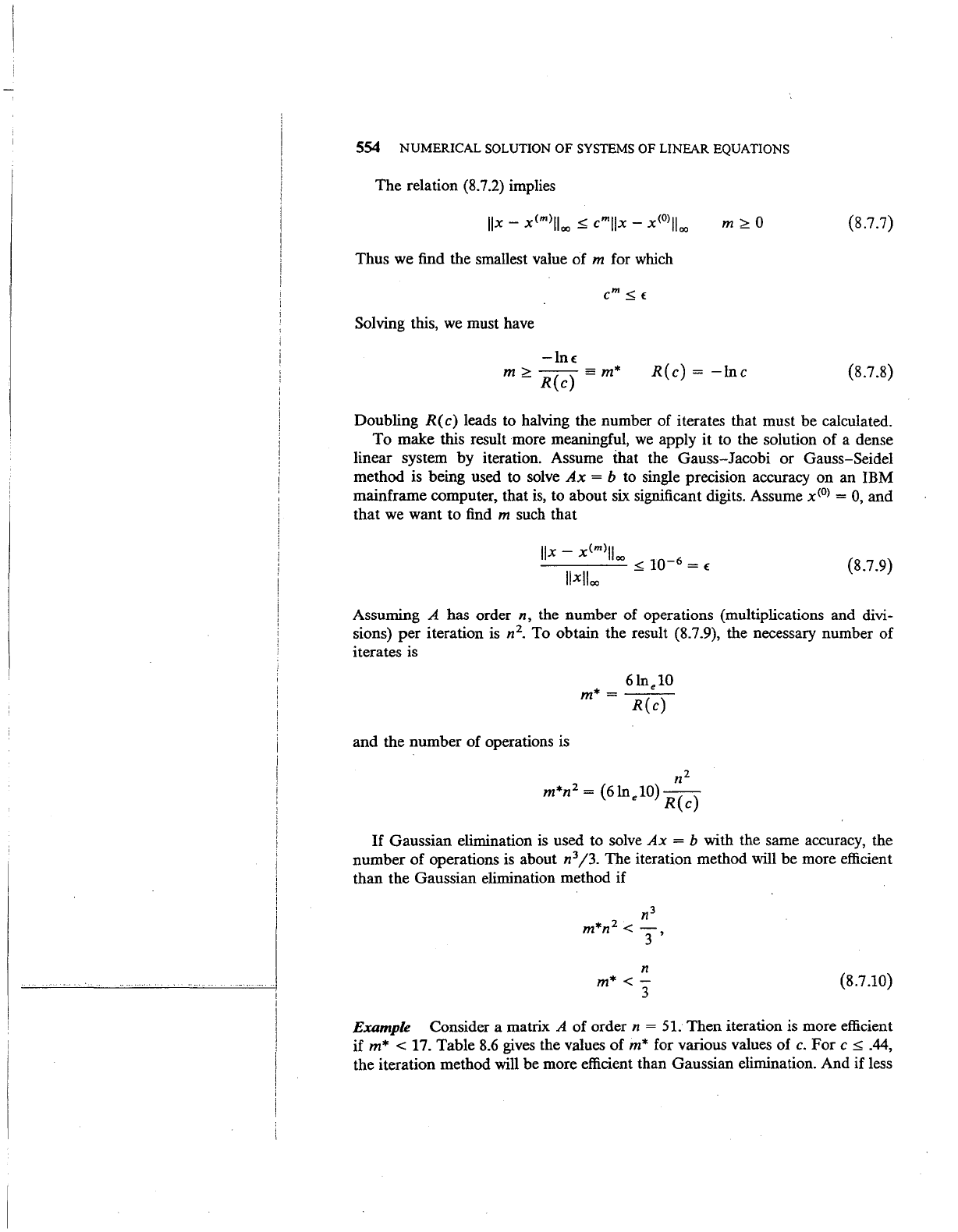
554
NUMERICAL SOLUTION
OF
SYSTEMS OF LINEAR EQUATIONS
The relation (8.7.2) implies
m
~
0
Thus we find the smallest value of m for which
Solving this,
we
must have
-ln£
m>--=m*
-
R(c)
R(c)
=
-lnc
(8.7.7)
{8.7.8)
Doubling
R(c)
leads to halving the number of iterates that must be calculated.
To
make this result more meaningful,
we
apply it to the solution of a dense
linear system by iteration. Assume
that the Gauss-Jacobi or Gauss-Seidel
method is being used to solve
Ax
= b to single precision accuracy on an IBM
mainframe computer, that
is,
to about six significant digits. Assume
x<
0
> =
0,
and
that
we
want to find m such that
(8.7.9)
Assuming
A has order
n,
the number of operations (multiplications and divi-
sions)
per
iteration is n
2
•
To obtain the result (8.7.9), the necessary number of
iterates is
6In,
10
m*=
---
R(c)
and the number of operations
is
n2
m*n
2
= {6ln
10)--
e
R(c)
If
Gaussian elimination is used to solve
Ax
= b with the same accuracy, the
number of operations is about n
3
j3.
The iteration method will be more efficient
than the Gaussian elimination method if
n
m*
<-
3
(8.7 .10)
Example Consider a matrix A of order n =
51.
Then iteration is more efficient
if
m* < 17. Table
8.6
gives the values of m* for various values of
c.
For
c::;;
.44,
the iteration method will be more efficient than Gaussian elimination. And if less
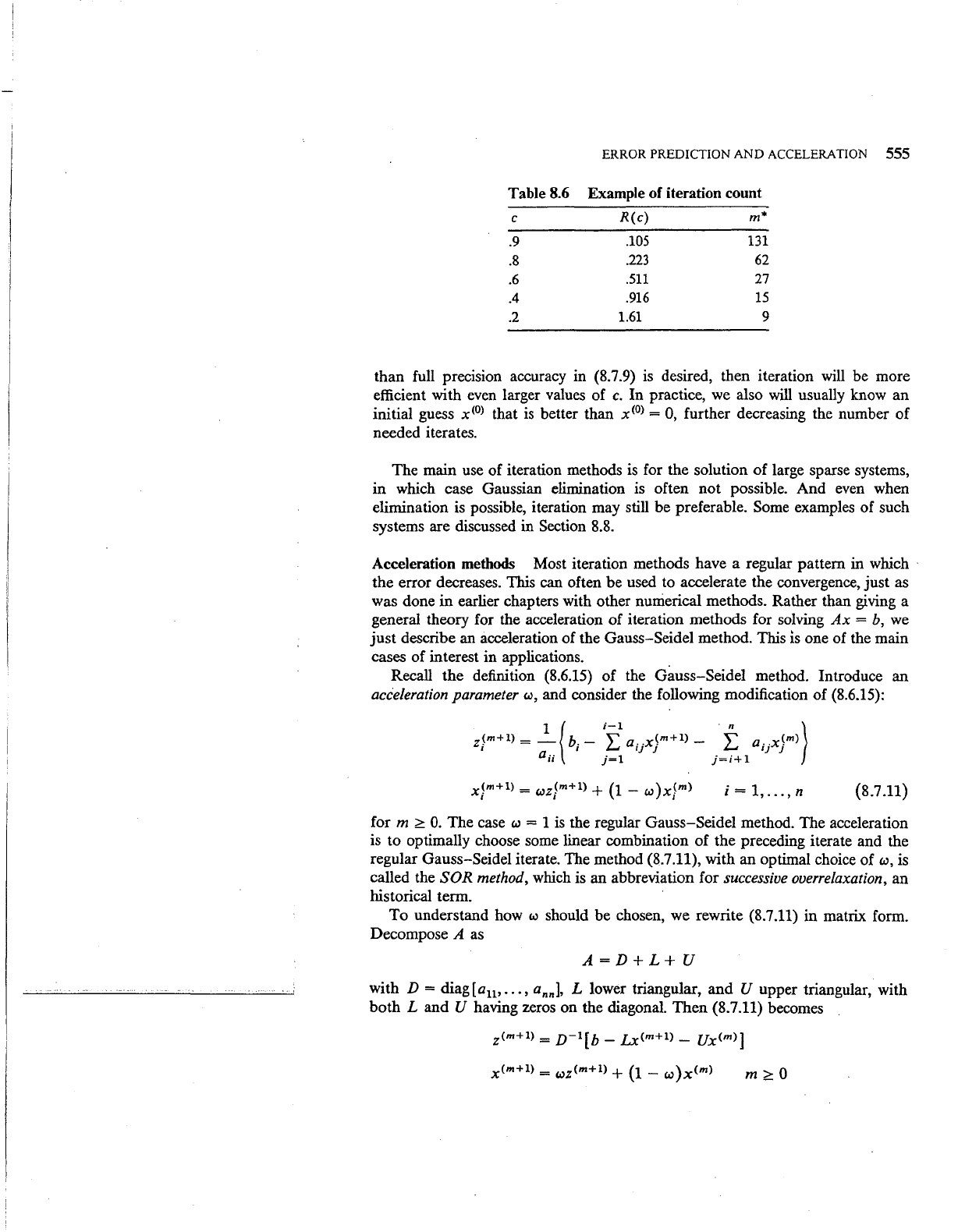
ERROR PREDICTION
AND
ACCELERATION
555
Table8.6 Example of iteration count
c
R(c)
m*
.9
.105
131
.8
.223
62
.6
.511
27
.4
.916
15
.2
1.61
9
than full precision accuracy in (8.7.9)
is
desired, then iteration will be more
efficient with even larger values of
c.
In practice, we also
will
usually know an
initial guess
x<
0
l
that
is
better than
x<
0
l
=
0,
further decreasing the number of
needed iterates.
The main use of iteration methods
is
for the solution of large sparse systems,
in
which case Gaussian elimination is often not possible. And even when
elimination is possible, iteration may still be preferable.
Some examples of such
systems are discussed in
Section 8.8.
Acceleration methods Most iteration methods have a regular pattern in which ·
the error decreases. This can often be used to accelerate the convergence, just as
was done
in
earlier chapters with other numerical methods. Rather than giving a
general theory for the acceleration of iteration methods for solving
Ax
= b,
we
just
describe an acceleration of the Gauss-Seidel method. This
is
one of the main
cases of interest in applications. .
Recall the definition
(8.6.15) of the Gauss-Seidel method. Introduce
an
acceleration parameter "'· and consider the following modification of (8.6.15):
z~m+l)
=
2_{b·-
i~l
a ..
x~m+l)-
.
~
a.
-X~m)}
, a ,
i-
,
1 1
i-
,
1 1
ii
j=l
j=i+l
x~m+l)
=
wz~m+l)
+
(1-
w)x~m)
l l l
i = 1,
...
, n
(8.7 .11)
for m
;;;::
0.
The case w = 1
is
the regular Gauss-Seidel method. The acceleration
is to optimally choose some linear combination of the preceding iterate and the
regular Gauss-Seidel iterate. The method
(8.7.11), with an optimal choice of w, is
called the
SOR
method, which is an abbreviation for successive overrelaxation, an
historical term.
To
understand how w should be chosen, we rewrite (8.7.11) in matrix form.
Decompose
A as
A=D+L+U
with D = diag [
aw
...
, a
nnl,
L lower triangular,
and
U upper triangular, with
both
L and U having zeros on the diagonal.
Then
(8.7.11) becomes
z<m+ll =
D-l[b-
Lx<m+l)-
Ux<m>]
x<m+l) = wz<m+l) +
(1-
w)x<m)
m;;;::
0
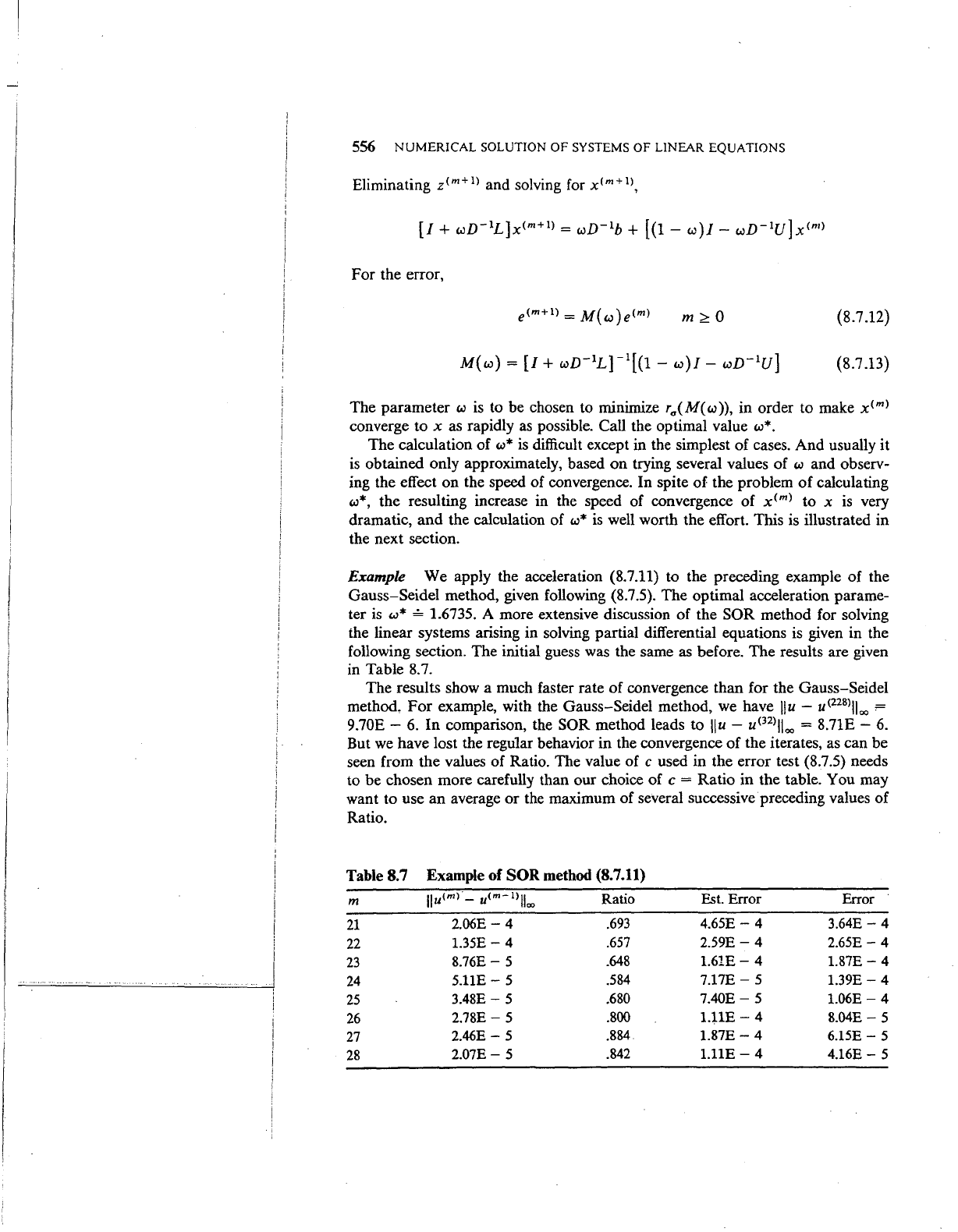
556
NUMERICAL
SOLUTION
OF
SYSTEMS
OF
LINEAR EQUATIONS
Eliminating
z<m+l)
and solving
for
x<m+l),
For the error,
e<m+i)
=
M(w
)e<m)
m~O
(8.7.12)
(8.7 .13)
The parameter w
is
to be chosen to minimize r
0
(M(w)),
in order to make
x<ml
converge to x as rapidly
as
possible. Call the optimal value w*.
The calculation of
w*
is
difficult except in the simplest of cases. And usually it
is
obtained only approximately, based
on
trying several values of w and observ-
ing the effect
on
the speed of convergence. In spite
of
the problem
of
calculating
w*, the resulting increase in the speed of convergence of
x<ml
to x
is
very
dramatic,
and
the calculation of
w*
is
well worth the effort. This is illustrated in
the next section.
Example We apply the acceleration (8.7.11) to the preceding example of the
Gauss-Seidel method, given following
(8.7.5). The optimal acceleration parame-
ter
is
w*
~
1.6735. A more extensive discussion of the SOR method for solving
the linear systems arising in solving partial differential equations is given in the
following section. The initial guess was the same
as
before. The results are given
in Table
8.7.
The results show a much faster rate of convergence than for the Gauss-Seidel
method,
For
example, with the Gauss-Seidel method,
we
have
l!u-
u<
228
llloo
;=
9.70E -
6.
In
comparison, the SOR method leads to
l!u
-
u(32llloo
= 8.71E - 6.
But
we
have lost the regular behavior
in
the convergence of the iterates, as can be
seen from the values of Ratio. The value of
c used in the error test (8.7.5) needs
to be chosen more carefully than our choice of
c = Ratio in the table. You may
want to use an average or the maximum of several successive preceding values of
Ratio.
Table
8.7
Example
of SOR
method
(8.7.11)
m
nu<ml
-
u<m-l)llco
Ratio Est. Error Error
21
2.06E-
4
.693
4.65E-
4
3.64E-
4
22
1.35E-
4
.657
2.59E-
4
2.65E-
4
23
8.76E-
5
.648
1.61E-
4
1.87E-
4
24
5.11E-
5
.584
7.17E-5
1.39E-
4
25
3.48E-
5
.680
7.40E-
5
1.06E-
4
26
2.78E-
5
.800
l.llE-
4
8.04E-
5
27
2.46E-
5
.884
1.87E-
4
6.15E-
5
28
2.07E-
5
.842
l.llE-
4
4.16E-
5
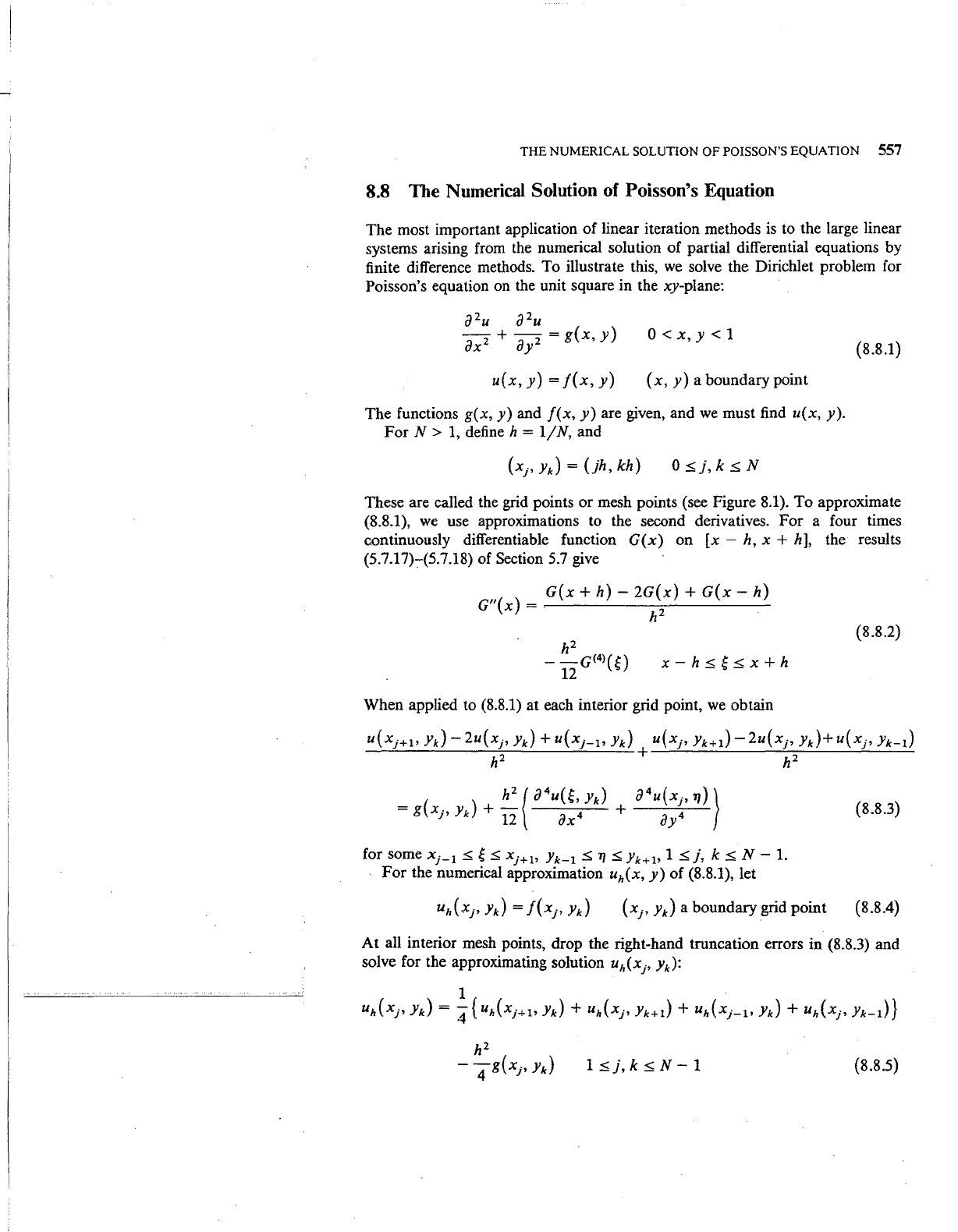
THE
NUMERICAL SOLUTION
OF
POISSON'S EQUATION 557
8.8 The Numerical Solution of Poisson's Equation
The most important application of linear iteration methods
is
to the large linear
systems arising
from
the numerical solution of partial differential equations by
finite difference methods. To illustrate this,
we
solve the Dirichlet problem for
Poisson's equation on the unit square in the xy-plane:
0
<X,
y < 1
(8.8.1)
u(x,y)
=j(x,y)
(
x,
y)
a boundary point
The functions
g(x,
y)
and
f(x,
y)
are given, and
we
must
find
u(x,
y).
For
N >
1,
define h =
ljN,
and
0
5,j,
k
.:$;
N
These are called the grid points
or
mesh points (see Figure 8.1). To approximate
(8.8.1),
we
use approximations to the second derivatives.
For
a four times
continuously differentiable function
G(x)
on
[x
- h, x + h), the results
(5.7.17)-:-(5.7.18) of Section 5.7
give
G(x
+h)-
2G(x)
+
G(x-
h)
G"(x)
=.
hz
(8.8.2)
When applied
tb
(8.8.1) at each interior grid point,
we
obtain
u(
xj+
1
,
Yk)-
2u(
xj,
Yk) +
u(
xj_
1
,
Yk)
u(
xj,
Yk+
1
)-
2u{
xj,
Yk
)+
u(
xj,
Yk-
1
)
h2
+
h2
(8.8.3)
for some
xj_
1
5,
g
5,
xj+
1
,
Yk-
1
.:$;
'T/
5,yk+
1
,
15,j,
k
5,
N
-1.
For
the numerical approximation uh(x,
y)
of (8.8.1), let
(xj,
Yk) a boundary grid point (8.8.4)
At all interior mesh points, drop the right-hand truncation errors in (8.8.3) and
solve for the approximating solution
uh(xj,
Yk):
1
uh(xj,
Yk) = 4 { uh(xj+1•
Yk)
+
uh(xj,
Yk+1) +
uh(xj-1•
Yk)
+
uh{xj,
Yk-1)}
h2
-
4g(xj,
Yk)
(8.8.5)
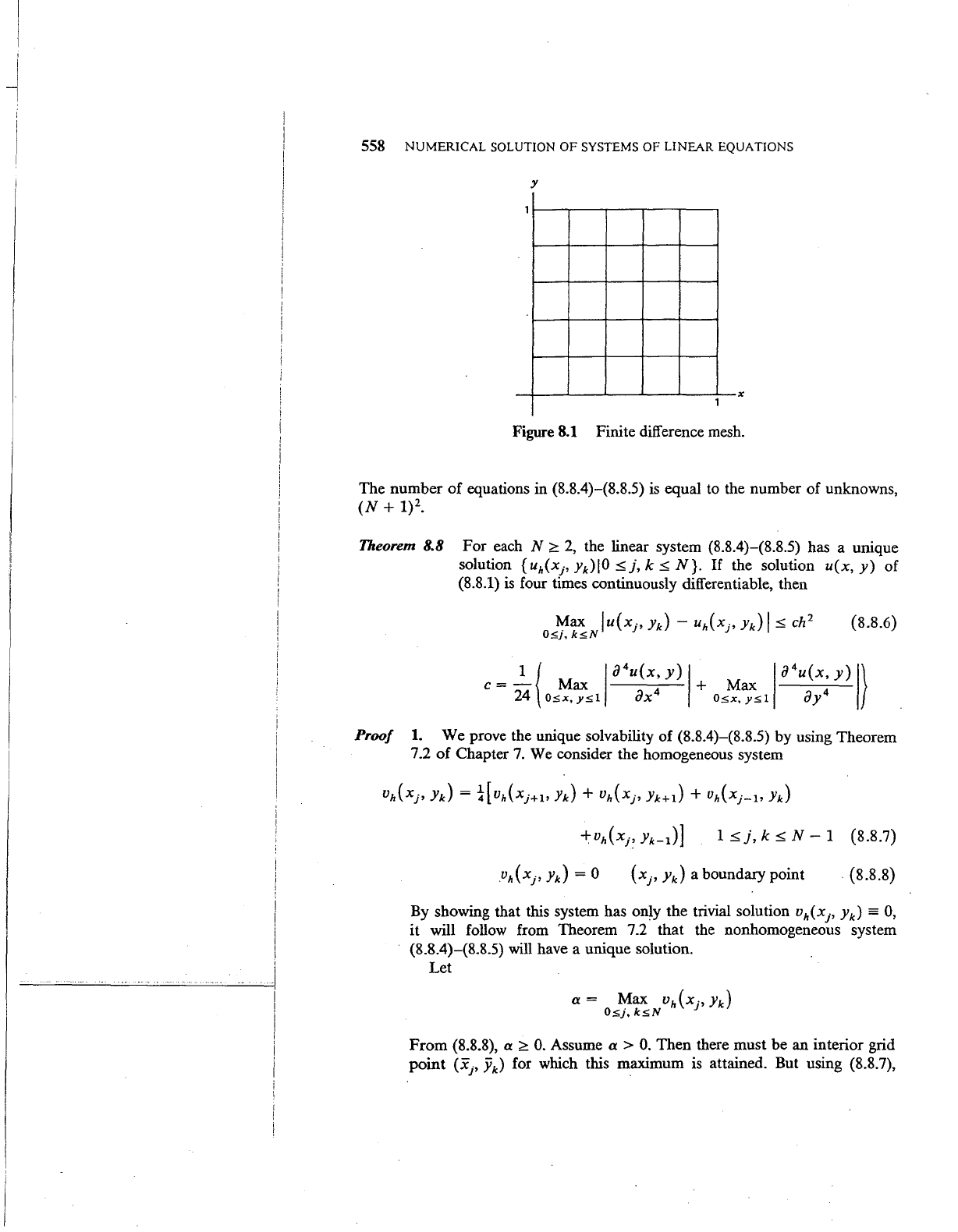
558
NUMERICAL
SOLUTION
OF
SYSTEMS OF LINEAR EQUATIONS
y
1
X
1
Figure
8.1
Finite difference mesh.
The
number
of
equations in (8.8.4)-(8.8.5) is equal to the number
of
unknowns,
(N
+ 1)
2
•
Theorem 8.8
For
each N
;;:::
2,
the linear system (8.8.4)-(8.8.5) has a unique
solution {
uh(xp
Yk)IO
~j,
k
~
N
}.
If
the solution u(x, y)
of
(8.8.1)
is
four times continuously differentiable, then
(8.8.6)
c
=-
Max +
Max
1 (
la
4
u(x,y)l
'a
4
u(x,y)l)
24
O.sx,y.sl
ax
4
O.sx,y.sl
ay
4
Proof
1.
We prove the unique solvability
of
(8.8.4)-(8.8.5)
by
using Theorem
7.2
of
Chapter
7.
We consider the homogeneous system
1
~j,
k
~
N-
1 (8.8.7)
(xj, Yk) a boundary point . (8.8.8)
By showing that this system has only the trivial solution
uh(xp
Yk) = 0,
it
will follow from Theorem 7.2 that the nonhomogeneous system
(8.8.4)-(8.8.5) will have a unique solution.
Let
From
(8.8.8), a
;;:::
0.
Assume a >
0.
Then there must
be
an
interior grid
point
(.X.,
jik) for which this maximum is attained. But using (8.8.7),
J .
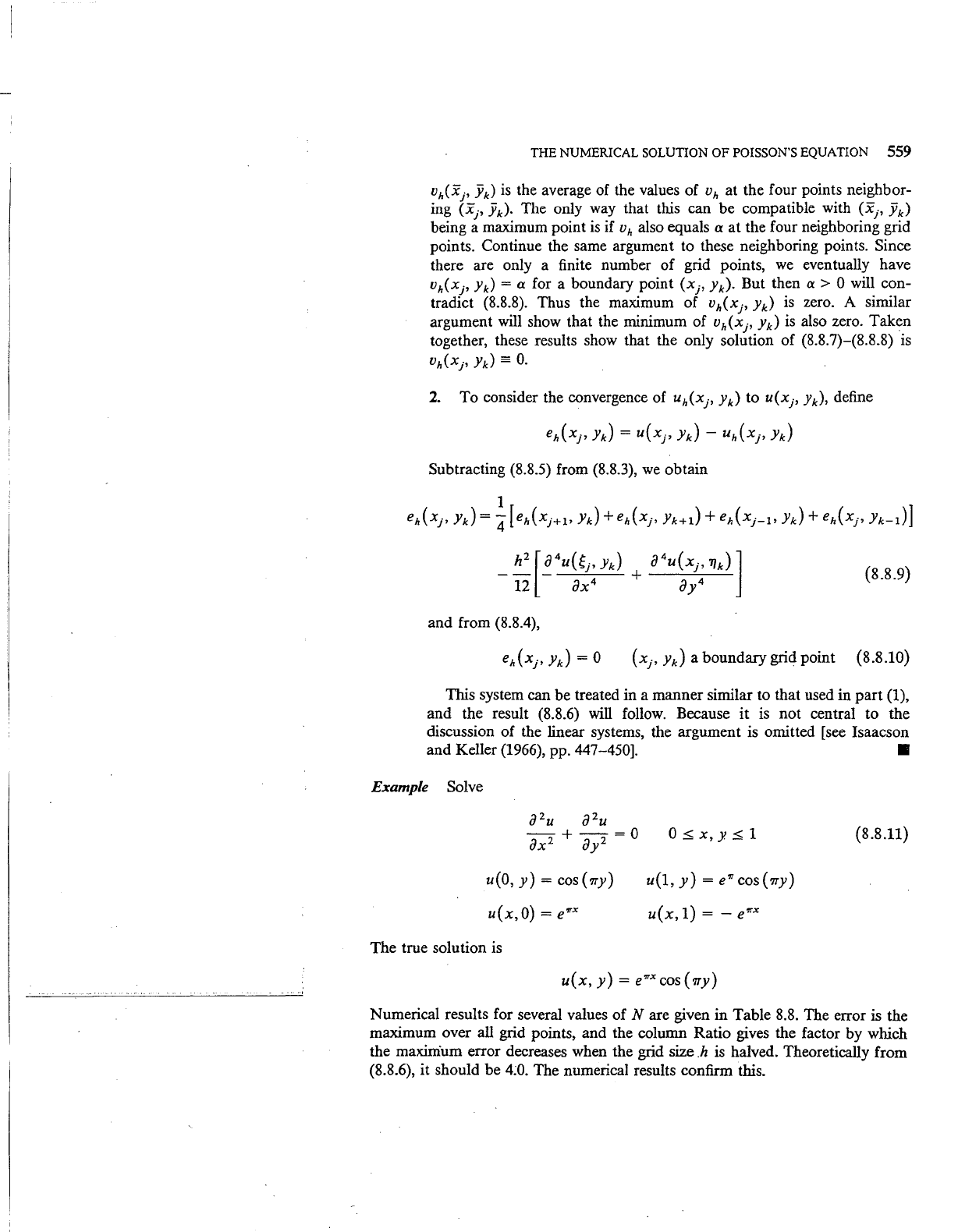
THE NUMERICAL SOLUTION
OF
POISSON'S EQUATION
559
vh(:Xp Yk)
is
the average of the values
of
vh
at the four points neighbor-
ing
(xp
Yk). The only way that this can
be
compatible with
(xj,
Yk)
being a maximum point
is
if
vh
also equals a
at
the four neighboring grid
points. Continue the same argument to these neighboring points. Since
there are only a finite number
of
grid points, we eventually have
vh(xj,
Yk) = a for a boundary point
(xj,
Yk).
But then a > 0 will con-
tradict (8.8.8). Thus the maximum
of
vh(xj,
Yk) is zero. A similar
argument will show that the minimum
of
vh(xj,
Yk) is also zero. Taken
together, these results show that the only solution
of
(8.8.7)-(8.8.8) is
vh(xp
Yk) =
0.
2.
To
consider the convergence of
uh(xj,
Yk)
to
u(xj,
Yk), define
Subtracting (8.8.5) from (8.8.3), we obtain
1
eh(
xj,
Yk)
= 4 [ eh(
xj+1,
Yk) + eh(
xj,
Yk+I)
+ eh(
xj-1>
Yk) +
eh(xj,
Yk-1)]
-
h2[~4u(~j,yk)
+
a4u(xj,1Jk)l
12
ax
4
ay
4
(8.8.9)
and from (8.8.4),
eh(xj,
Yk) = 0
(xj,
Yk) a boundary grid point {8.8.10)
This system can be treated
in
a manner similar to that used in
part
(1),
and the result (8.8.6) will follow. Because
it
is
not
central to
the
discussion
of
the linear systems, the argument is omitted [see Isaacson
and
Keller (1966), pp. 447-450]. •
Example Solve
u(O,
y)
=
cos('1Ty)
u(x,
0)
=
e'ITx
The true solution is
0
~X,
y
~
1
u{1,
y)
=
e'ITcos('ITy)
u(x,
1)
= -
e'ITx
u(x,
y)
= e"xcos('1Ty)
{8.8.11)
Numerical results for several values
of
N are given in Table 8.8. The error is the
maximum over all grid points, and the column Ratio gives the factor by which
the maximum error decreases when the grid size
.h
is halved. Theoretically from
(8.8.6), it should
be
4:0. The numerical results confirm this.
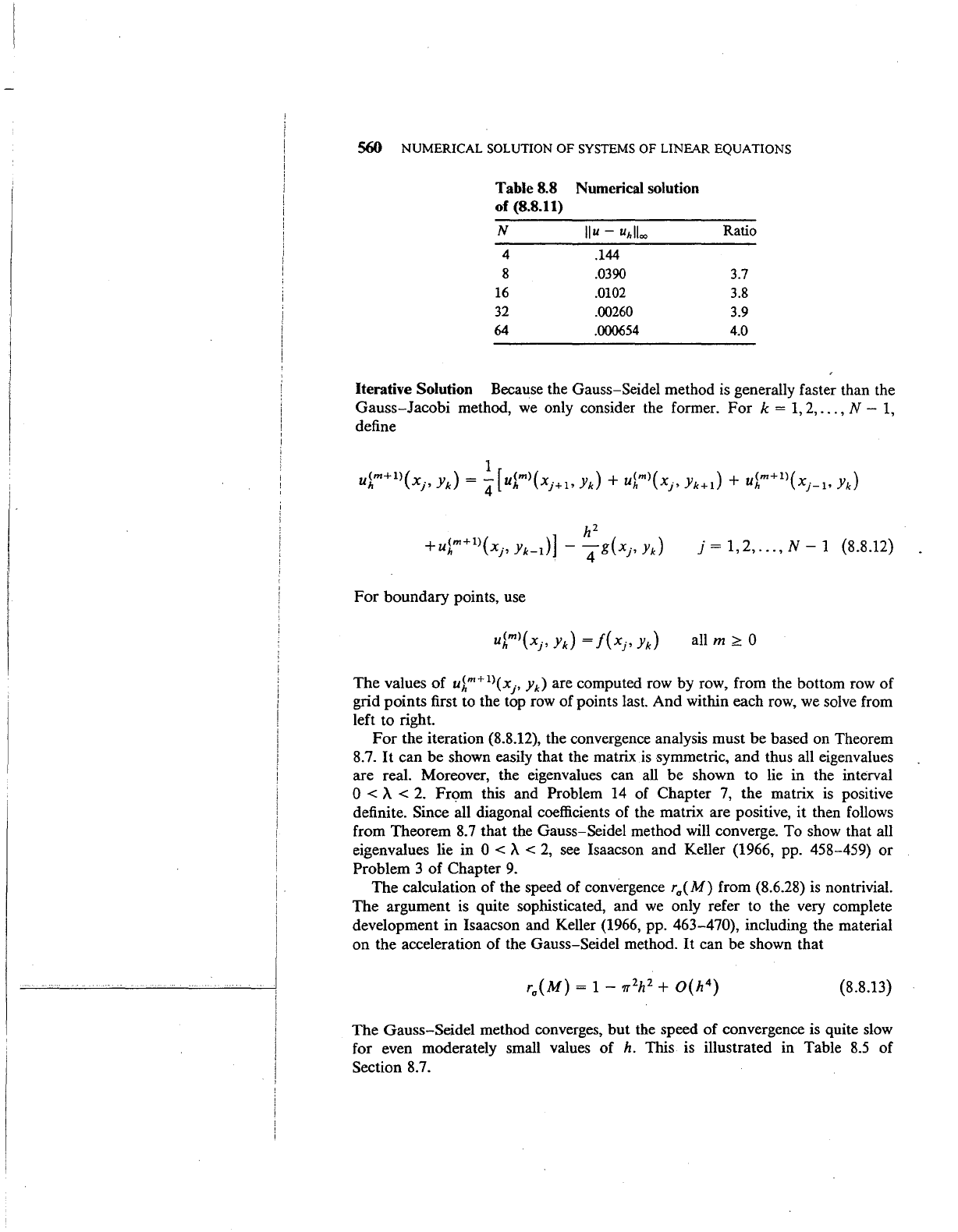
I
i
I
560
NUMERICAL SOLUTION
OF
SYSTEMS OF LINEAR EQUATIONS
Table 8.8 Numerical solution
of (8.8.11)
N
llu-
uhlloo
Ratio
4
.144
8 .0390 3.7
16 .0102
3.8
32
.00260
3.9
64 .000654 4.0
Iterative Solution Because the Gauss-Seidel method
is
generally faster than the
Gauss-Jacobi method,
we
only consider the former.
For
k =
1,
2,
...
,
N-
1,
define
j =
1,2,
...
,
N-
1 (8.8.12)
For
boundary points, use
all
m
~
0
The values of
uim+ll(xp
Yk)
are computed row by row, from the bottom row of
grid points first to the top row of points last. And within each row, we solve from
left to right.
For
the iteration (8.8.12), the convergence analysis must be based on Theorem
8.7.
It
can be shown easily that the matrix
is
symmetric, and thus all eigenvalues
are real. Moreover, the eigenvalues can all be shown to lie in the interval
0
< A <
2.
From this and Problem 14 of Chapter
7,
the matrix
is
positive
definite. Since all diagonal coefficients of the matrix are positive, it then follows
from Theorem
8.
7 that the Gauss-Seidel method will converge. To show that all
eigenvalues lie in
0 < A <
2,
see Isaacson and Keller (1966, pp. 458-459) or
Problem 3 of Chapter
9.
The calculation of the speed of convergence
ra(M)
from (8.6.28)
is
nontrivial.
The argument
is
quite sophisticated, and
we
only refer to the very complete
development in Isaacson and Keller
(1966, pp. 463-470), including the material
on the acceleration of the Gauss-Seidel method.
It
can be shown that
(8.8.13)
The Gauss-Seidel method converges,
but
the speed of convergence is quite slow
for even moderately small values of
h.
This is illustrated in Table
8.5
of
Section
8.7.
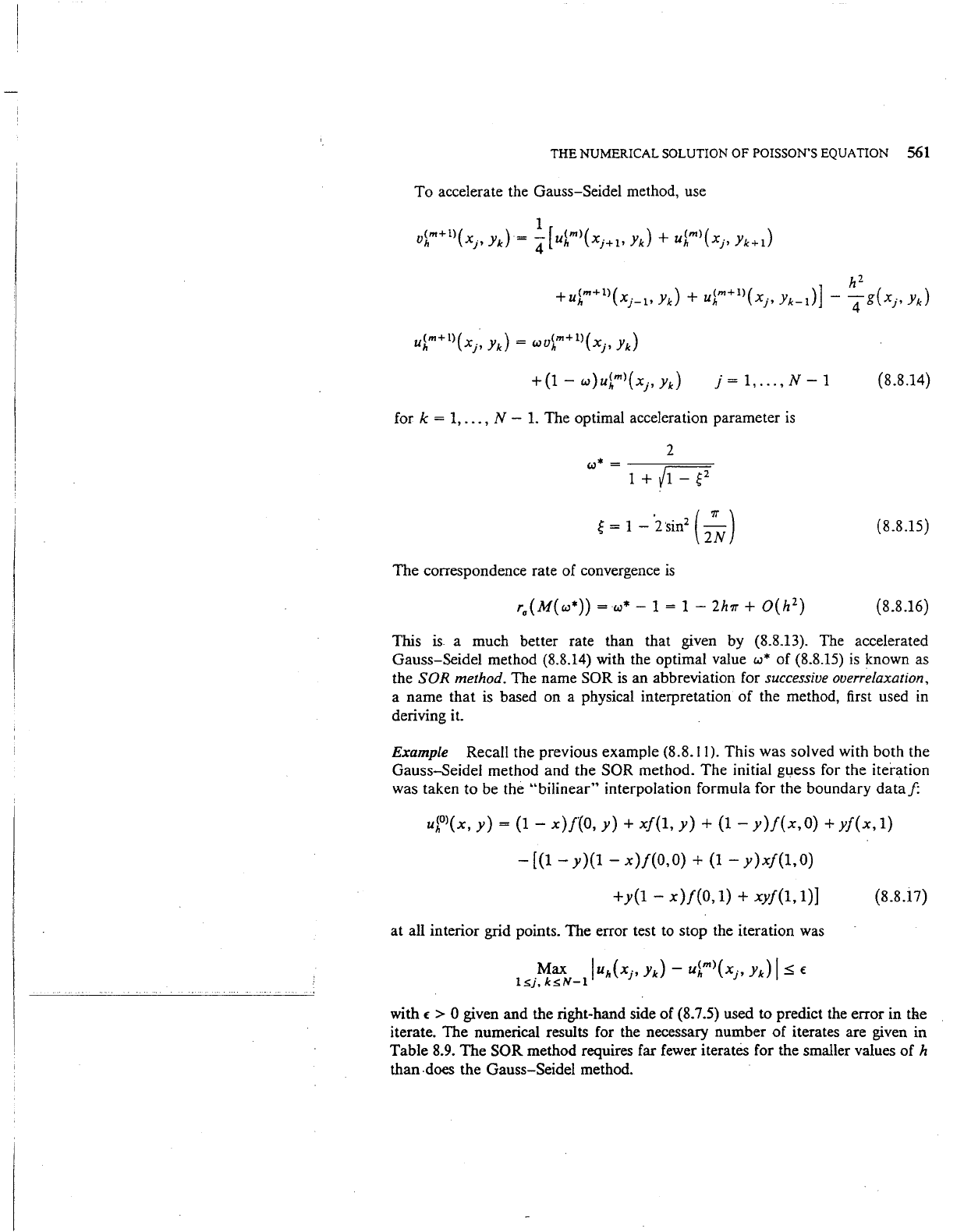
THE
NUMERICAL SOLUTION
OF
POISSON'S EQUATION
561
To accelerate the Gauss-Seidel method, use
u<m+!l(x. y ) = wu<m+!l(x.
y)
h
J'
k h
J'
k
j=I,
...
,N-I
(8.8.I4)
for
k = I,
...
, N - I. The optimal acceleration parameter
is
2
w*
=
-----,===-
I+~
(8.8.I5)
The correspondence rate of convergence
is
(8.8.16)
This
is.
a much better rate than that given by (8.8.13). The accelerated
Gauss-Seidel method (8.8.14) with the optimal value
w* of (8.8.15)
is
known as
the
SOR
method. The name SOR
is
an abbreviation for successive ouerrelaxation,
a name that
is
based on a physical interpretation of the method, first used
in
deriving it.
Example Recall the previous example (8.8.11). This was solved with both the
Gauss-Seidel method and the
SOR method. The initial guess for the iteration
was taken to be the
"bilinear" interpolation formula for the boundary
dataf:
ui
0
>(x,
y)
=
(1-
x)l(O,
y)
+
xf(I,
y)
+(I-
y)f(x,O)
+
yf(x,
I)
-
[(1-
y)(l-
x)f(O,O)
+(I-
y)x/(1,0)
+y(I-
x)f(O,
I)+
xyf(l,
I)]
(8.8.17)
at all interior grid points. The error test
to
stop the iteration was
with£ > 0 given and the right-hand side of (8.7.5) used to predict the error in the
iterate. The numerical results for the necessary number of iterates are given in
Table
8.9.
The SOR method requires far fewer iterates for the smaller values of h
than
-does
the Gauss-Seidel method.
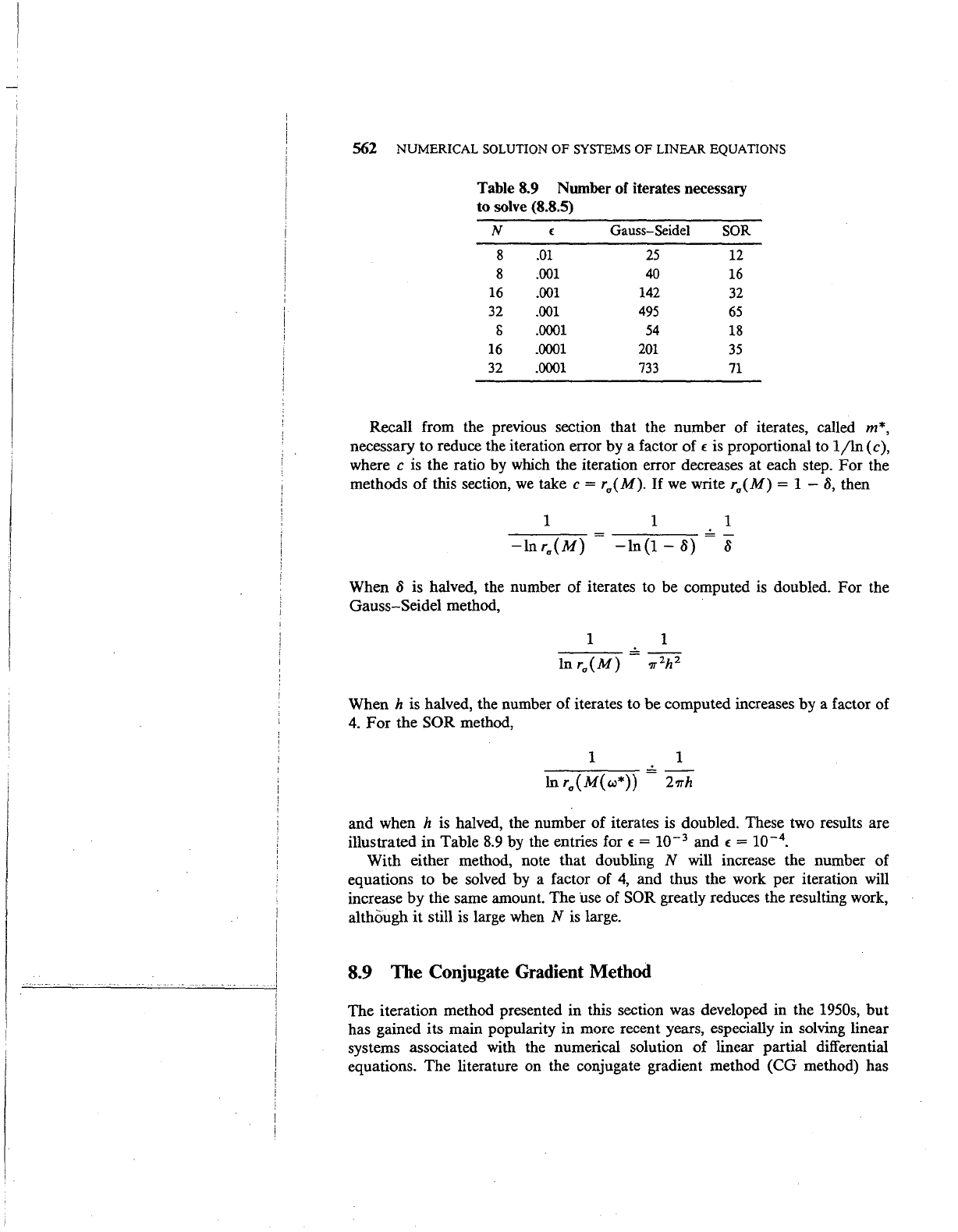
562 NUMERICAL SOLUTION
OF
SYSTEMS OF LINEAR EQUATIONS
Table 8.9
Number
of
iterates necessary
to solve (8.8.5)
N
(
Gauss-Seidel
SOR
8
.01
25
12
8
.001
40
16
16
.001
142
32
32
.001
495
65
!)
.0001
54
18
16
.0001
201
35
32
.0001
733
71
Recall from the previous section that the number of iterates, called m*,
necessary to reduce the iteration error by a factor of
t:
is proportional to 1
jln
(c),
where c
is
the ratio by which the iteration error decreases at each step.
For
the
methods of this section,
we
take c = r
0
(M).
If
we
write r
0
(M)
= 1
-~'then
1 1 1
-~:----:--
-ln(1-8)
8
When 8 is halved, the number of iterates to be computed
is
doubled. For the
Gauss-Seidel method,
1 1
ln r
0
(M)
=
7T
2
h
2
When h is halved, the number of iterates to be computed increases by a factor of
4.
For
the SOR method,
1 1
---------=
---
ln ra(M(w*))
and when h is halved, the number of iterates is doubled. These two results are
illustrated in Table
8.9
by the entries
fort:=
10-
3
and
t:
=
10-
4
•
With either method, note that doubling N will increase the number of
equations to be solved by a factor of
4,
and thus the work per iteration will
increase by the same amount. The
use of SOR greatly reduces the resulting work,
although
it
still is large when N is large.
8.9 The Conjugate
Gradient
Method
The iteration method presented in this section was developed in the 1950s, but
has gained its main popularity in more recent years, especially in solving linear
systems associated with the numerical solution of linear partial differential
equations. The literature on the conjugate gradient method (CG method) has
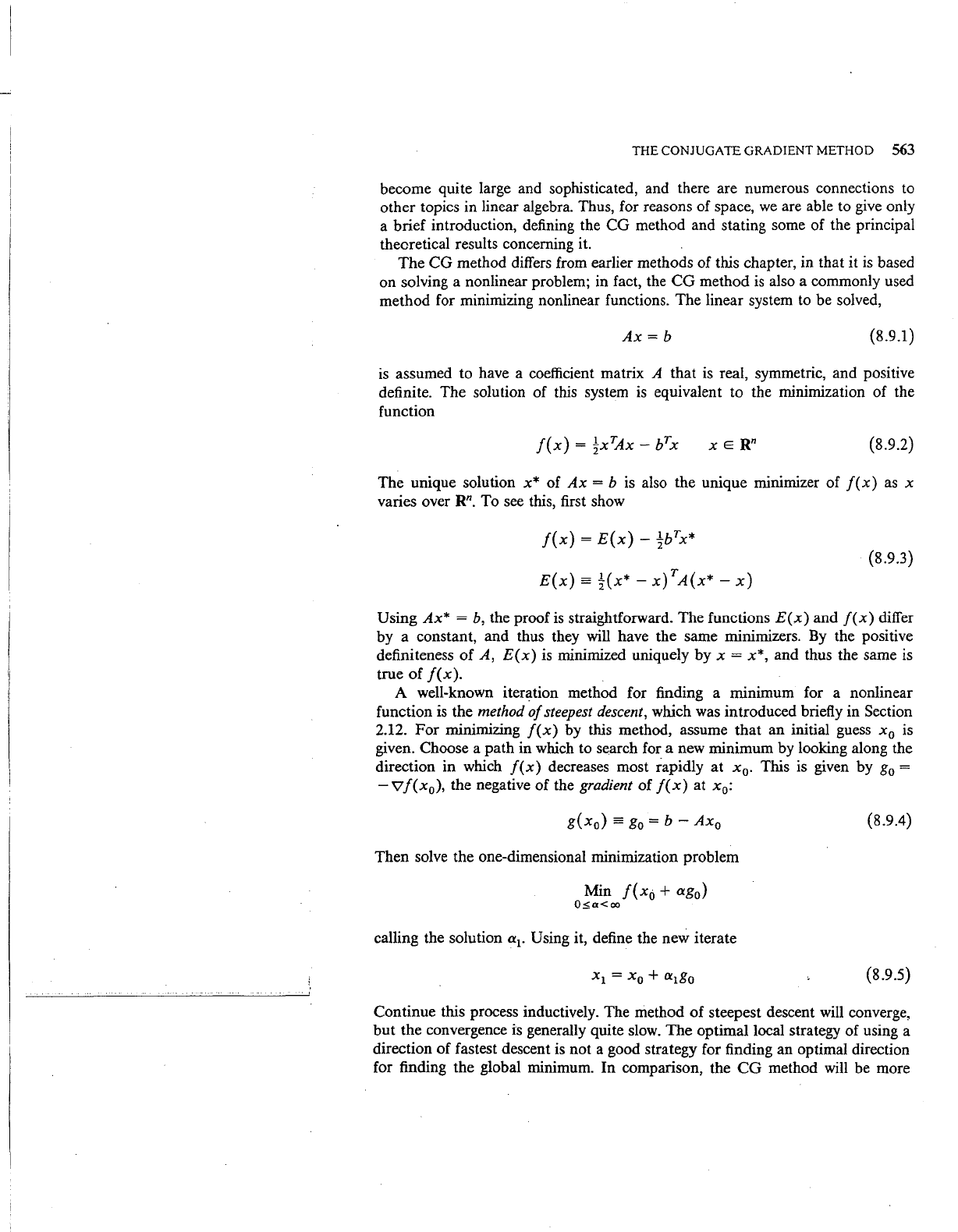
THE CONJUGATE GRADIENT METHOD
563
become quite large and sophisticated, and there are numerous connections to
other
topics
in
linear algebra. Thus, for reasons
of
space, we are able to give only
a
brief
introduction, defining the
CG
method
and
stating some
of
the principal
theoretical results concerning it.
The
CG
method differs from earlier methods
of
this chapter, in that
it
is based
on
solving a nonlinear problem; in fact, the
CG
method is also a commonly used
method
for minimizing nonlinear functions.
The
linear system to
be
solved,
Ax=
b
(8.9.1)
is assumed
to
have a coefficient matrix A
that
is real, symmetric,
and
positive
definite.
The
solution
of
this system is equivalent
to
the minimization
of
the
function
(8.9.2)
The
unique solution x*
of
Ax=
b is also
the
unique minimizer
of
f(x)
as x
varies over
Rn.
To
see this, first show
f(x)
=
E(x)-
tbTx*
(8.9.3)
E (
x)
= H
x*
-
x)
T A (
x*
-
x)
Using
Ax*
=
b,
the proof is straightforward.
The
functions
E(x)
and
f(x)
differ
by
a constant,
and
thus they will have
the
same minimizers. By the positive
definiteness
of
A,
E(x)
is minimized uniquely
by
x = x*,
and
thus the same is
true
of
f(x).
A well-known iteration method for finding a
minimum
for a nonlinear
function is the
method
of
steepest descent, which was introduced briefly
in
Section
2.12.
For
minimizing
f(x)
by this method, assume
that
an
initial guess x
0
is
given. Choose a
path
in
which
to
se.arch for a new
minimum
by looking along the
direction
in
which
f(x)
decreases
most
rapidly
at
Xo.
This is given by
go=
-\lj(x
0
),
the negative
of
the gradient
of
f(x)
at x
0
:
(8.9.4)
Then
solve the one-dimensional minimization
problem
Min
f(x
0
+
ag
0
)
O~a<oo
calling the solution a
1
.
Using it, define the new iterate
(8.9.5)
Continue
this process inductively.
The
method
of
steepest descent will converge,
but
the
convergence is generally quite slow.
The
optimal
local strategy
of
using a
direction
of
fastest descent is
not
a good strategy for finding
an
optimal direction
for finding
the
global minimum.
In
comparison, the
CG
method will be more
